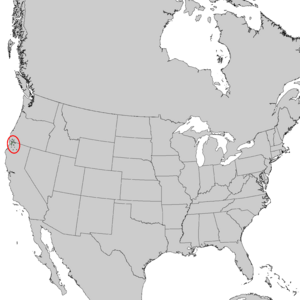Picea breweriana facts for kids
Quick facts for kids Picea breweriana |
|
|---|---|
 |
|
| Brewer spruce, Ridge above Bear Lake, Siskiyou Mountains, Ca. | |
| Conservation status | |
| Scientific classification | |
| Genus: |
Picea
|
| Species: |
breweriana
|
 |
|
| Natural range of Picea breweriana | |
 |
|
| Close-up of natural range of Picea breweriana | |
The Picea breweriana, often called Brewer spruce or weeping spruce, is a unique type of spruce tree. It grows naturally in western North America and is one of the rarest spruce trees on the continent. This tree was named after an American botanist, William Henry Brewer.
Contents
What the Brewer Spruce Looks Like
The Brewer spruce is a large evergreen tree. This means it stays green all year round and has cones. It can grow very tall, usually between 20 to 40 meters (about 65 to 130 feet), and sometimes even taller, up to 54 meters (177 feet)! Its trunk can be as wide as 1.5 meters (5 feet).
The tree's bark is thin and has a scaly texture, looking purple-gray. The most special part of the Brewer spruce is its crown, which is the top part with branches and leaves. Its branches grow out straight, but then the smaller twigs hang down vertically, like curtains of leaves. This is why it's called the "weeping" spruce. Young trees (under 10-20 years old) don't have these weeping branches yet; they develop as the tree gets taller, usually after it reaches about 1.5 to 2 meters (5-6.5 feet).
The twigs are orange-brown and feel rough because they have tiny bumps. The leaves are like needles, about 15 to 35 millimeters (0.6 to 1.4 inches) long. They are flat and shiny dark green on top. If you look underneath, you'll see two white lines, which are rows of tiny pores called stomata. These pores help the tree breathe.
Cones and Seeds
The cones of the Brewer spruce are longer than those of most other spruce trees in North America. They hang down and are shaped like cylinders. When closed, they are about 8 to 15 centimeters (3 to 6 inches) long. They open up to be about 3 to 4 centimeters (1.2 to 1.6 inches) wide. The scales on the cones are smooth, thin, and flexible.
When the cones are young, they are dark purple. They change to a red-brown color about 5 to 7 months after the tree is pollinated. Inside the cones are black seeds, which are small, about 3 to 4 millimeters (0.1 to 0.16 inches) long. Each seed has a light brown wing that helps it fly away in the wind.
How It Grows
The Brewer spruce grows very slowly, usually less than 20 centimeters (8 inches) each year. It often grows on the tops of ridges where there's a lot of snow in winter. This snow melts slowly, giving the tree a steady supply of water in the spring. Even though it's dry in the summer, the tree can survive.
The tough conditions on these ridgetops mean that other faster-growing trees, like the Douglas fir, don't compete as much with the Brewer spruce. This tree is also very good at handling heavy snow and ice. Its strong branches and drooping twigs help the snow slide off easily, preventing damage.
Where the Brewer Spruce Lives
The Brewer spruce is only found in a specific area called the Klamath Mountains. This region is located in southwest Oregon and northwest California. It grows at medium to high elevations, from about 1000 to 2700 meters (3,300 to 8,900 feet) above sea level.
What the Brewer Spruce Is Used For
Outside of its natural home, the Brewer spruce is a very popular ornamental tree. People like to plant it in gardens, especially in Great Britain and Scandinavia. They love its dramatic weeping branches, which make it look very beautiful. This tree has even won an award called the Royal Horticultural Society's Award of Garden Merit for its beauty and ease of growing.
Images for kids
See also
 In Spanish: Pícea de Brewer para niños
In Spanish: Pícea de Brewer para niños









